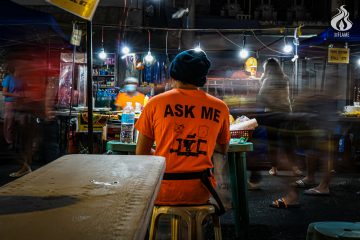
IN A dystopian world filled with watery graves and remnants of history, romantic gestures sink underwater as social and ecological issues submerge cities.
Barcelona is an adverse product of an alternative reality draped in mangled motifs.
Published by Avenida Publishing House, Barcelona is a dystopian graphic novella by Criselda Yabes, a Filipino writer, journalist and international correspondent.
The novella follows the newly-appointed Captain Rahel in his mission to bring Barcelona, a female leader of orphans in Manila, to the South because the city is on the verge of sinking underwater. However, a clash of history and uncertainty comes in as she is forced to decide whether to leave her painful past behind or drown in it.
Set in 2050, the novella uses first person narrative as Captain Rahel describes the Philippines’ situation and some of the well-known buildings of Manila, like the Museum of Natural History and the Metropolitan Theater. However, the narration was incoherent. The mixture of direct and internal dialogues made it hard to distinguish if the paragraph pertained to Captain Rahel’s thoughts or if he was conversing with another character.
Philippine and Greek historical references were incorporated as several figures and battles like Andres Bonifacio, Ferdinand Magellan, and the battle of Thermopylae were mentioned. These references were allusions to the predicament Captain Rahel and Barcelona faced. Aside from these issues, the references allude to war tactics for conquest and assassination as well as Captain Rahel’s form of expression. Even though these references were exceptionally placed within the narrative, they were overused. The references made the novella jaded and Captain Rahel was reduced to a living brochure for a tourist attraction.
Furthermore, the novella did not give proper justification to the dystopian world it was trying to portray in its blurb.
Barcelona started strong with its detailed milieu. It sparked the reader’s curiosity about how Manila was slowly sinking underwater, paired with an illustration of the Post Office (which, in real life, was damaged by a fire last year) and its surroundings covered with water. However, it did not display a dilapidated country. The backdrop was similar to the current state of the Philippines despite the novella being set in the future. One example was the personification of an emerald snake which referred to the hazy state of the Pasig River.
The ecological geography that shaped the dystopian world ended in a casual conversation. Captain Rahel and Barcelona talked about the ecological status of Manila but the effects were vague. It only provided brief descriptions of poverty and murky water, each paired with an illustration.
Jerico Marte created both the cover design and illustrations. These black-and-white illustrations portrayed the current subject in a paragraph. For instance, the illustration of the Post Office is drawn from Captain Rahel’s perspective. However, the graphic illustrations were better off used to highlight the adverse effects of dystopia instead of painting the obvious.
The novella incorporated the COVID-19 pandemic and the war on drugs during former president Rodrigo Duterte’s presidency for Barcelona’s background. She was traumatized as she lost family members in both incidents which contributed to her reluctance to leave Manila. As a result, the dystopian theme manifested in a character instead of illustrating a damaged world. Additionally, Barcelona’s past was fleshed out, making the social maladies more relevant than the current ecological issues.
Even if the novella’s beginning explicitly states its goal, the plot goes downhill. Aside from the aforementioned problems, misogyny was forcibly written at the last minute. The aide’s hatred for Barcelona and his sickness were the factors in his hostility towards women. However, the way it was written made him have a romantic attraction to her. The scene where the aide narrated Barcelona’s past with his uncle opened a romantic subplot. However, the attraction ceased abruptly and left questions that were never answered. The novella drifted to another topic which made the romantic side plot nonexistent.
“A man leader, that is good, you know what I mean? You’re a man, you know what I mean? We don’t need a woman.”
The novella did not focus on a singular issue, making it more confusing why Barcelona’s character was reduced to a love interest. Captain Rahel was a victim of romanticization as well. His sudden infatuation and longing for Barcelona opened a way to advertise Yabes’ novel Crying Mountain, a title interchangeably used with Below the Crying Mountain (2010). The novel was mentioned in a paragraph where Captain Rahel found a book that made him long for Barcelona.
It was a novel about my mother’s birthplace in the uprising of the past, but it tells the story of a love worth waiting for: Crying Mountain.
Crying Mountain and Barcelona were two different works set in different timelines and settings. While these books deal with different topics, they both share similar themes such as war and betrayal. Both novels also feature Philippine landmarks and various religions such as Christianity and Islam.
Overall, Barcelona failed to demonstrate the makings of a successful dystopian reality. Instead, it focused on various topics with no clear direction.
The novella laid out multiple issues. However, the opportunity to discuss these maladies was wasted as the ambiguous setup ended with a forced romantic attraction. The sudden romance was also a clear indication that Barcelona was a work created to promote Crying Mountain. F — T. A. Loseriaga



